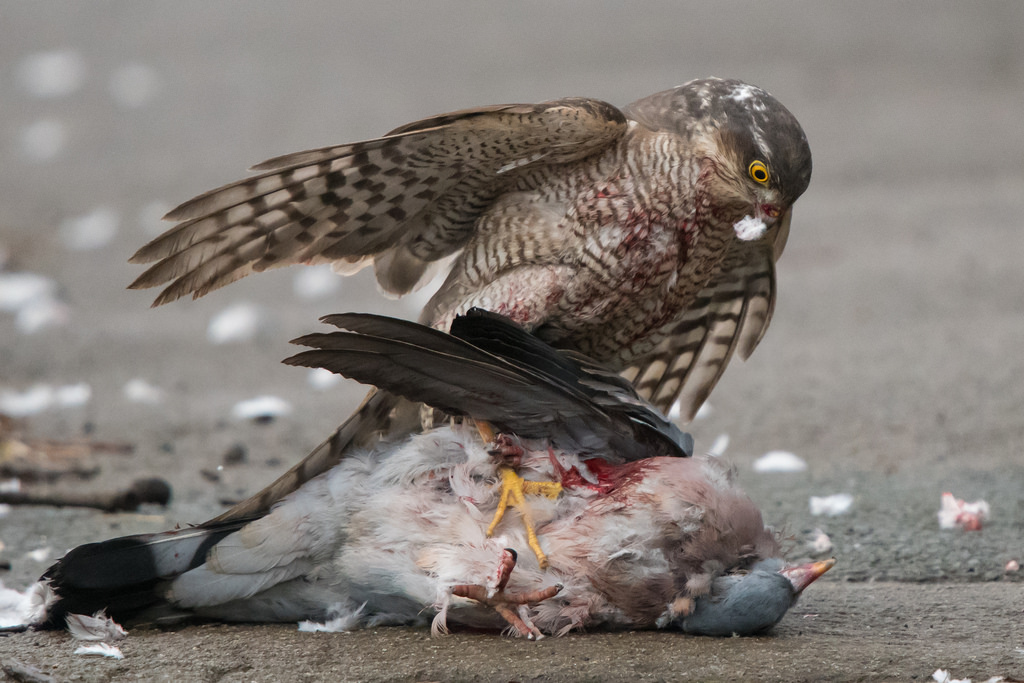
Tim writes: I was driving in South Yorkshire back in February when I spotted this female Sparrowhawk dispatching a Woodpigeon. I pulled in the car just beyond and leaned out of the window to photograph the encounter. Believe it or not a Woodpigeon weighs about 450g whereas a female Sparrowhawk weighs just 260g (and the smaller male weighs a mere 150g). That’s like a Bantamweight taking on a Heavyweight, though probably more like Amir Khan taking on Nicholas Soames (I’d pay good money to see that fight). The chilling detail of the Woodpigeon’s claw wrapped around the leg of the Sparrowhawk suggests it wasn’t dead. You can also see the Woodpigeon’s blood smeared across the Sparrowhawk’s chest. Nature red in tooth and claw.
[registration_form]
Great catch. I sometimes odd feelings with sparrowhawks. I love them, but when you hear a noise in your garden and see a sparrowhawk killing your favorite song thrush, there’s a bit of internal conflict. Song thrush chicks lose a parent, sparrowhawk chicks get a good meal. Swings and roundabouts.
I’ve seen this about three times now. I wonder if the goshawk was around in the numbers it should be at if this would be a far less frequent occurrence, the goshawks would be tearing into the wood pigeon population. Maybe this is a sign that we have a ecosystem out of sorts and the sparrowhawk is trying to take advantage of an (over?) abundant species it may not be best designed to tackle?
Like for many birds, the Wood Pigeon’s abundance is controlled by winter weather/food supply. A lot of Goshawks will not noticeably affect pigeon numbers. Lots more grey and white feathers about, however.
The Wood Pigeon is thriving on the food put out for Pheasants.
Spot on, Keith. About two-thirds of the food put out for Pheasants is eaten by ‘non-target species’, and the main beneficiaries are rats, pigeons and corvids (not including Ravens).
In the most definitive recent study the feeders were caged to prevent access by deer, otherwise the figure would have been even higher.
I’ve seen this once but seen hen Sparrowhawks attempt or succeed in taking several Collared Doves, Red Grouse (failed- grouse “kicked” it off and escaped)), Hen pheasant ( escaped) and Carrion Crow ( one success, one failure) What makes it all the more remarkable is that the hawk has to eat where the prey falls at least to start with as it is too heavy to move. I’ve also seen a male kill a Mistle Thrush that it couldn’t lift and ate where it fell. Goshawks could kill and carry all of these and probably do including the Sparrowhawk. the last Goshawk kill I saw was a Stock Dove but they apparently take lots of Magpies, Jays and Grey Squirrels too. Odd then that locally we seem to have lost our two breeding attempts to the local pheasant shoot keepers. Personally I want the hawks and would wish the bloody pheasant shoots (canned hunting of non-native birds without any care to what happens to local ecology) gone along with driven grouse.
Some hen Sparrowhawks seem to specialise in Woodpigeon, predation on Grey Partridge can be
a serious problem when trying to build up the latter’s numbers, and I suspect that Red Grouse are
tackled more frequently than supposed.
I think that nervous energy the bird’s have, helps them tackle these larger prey items, which are
then subdued by being eaten alive.
I have seen well grown Pheasant poults in early autumn, with most of one breast eaten through,
and the heart still beating.
Once also, I surprised a lovely blue male, on a very young Rabbit, this however, was a bridge too
far.
It is perhaps understandable, that Gamekeepers former hatred for this bird, resulted in its omission
from the protected list until 1966, until it’s numbers had been decimated by pesticides.
As enjoyable as it would be to watch, Khan versus Soames wouldn’t be a fight.
Amir Khan armed with 8 razor sharp 8″ long knifes taking on Nicholas Soames would be a more accurate analogy. They have the endearing habit of starting to eat their prey a long time before it is actually dead.
Unfortunately, the Sparrow Hawk eats its prey alive. Gruesome in the extreme.
In the last drought I witnessed a Kestrel try to take a Wood Pigeon. Desperation.